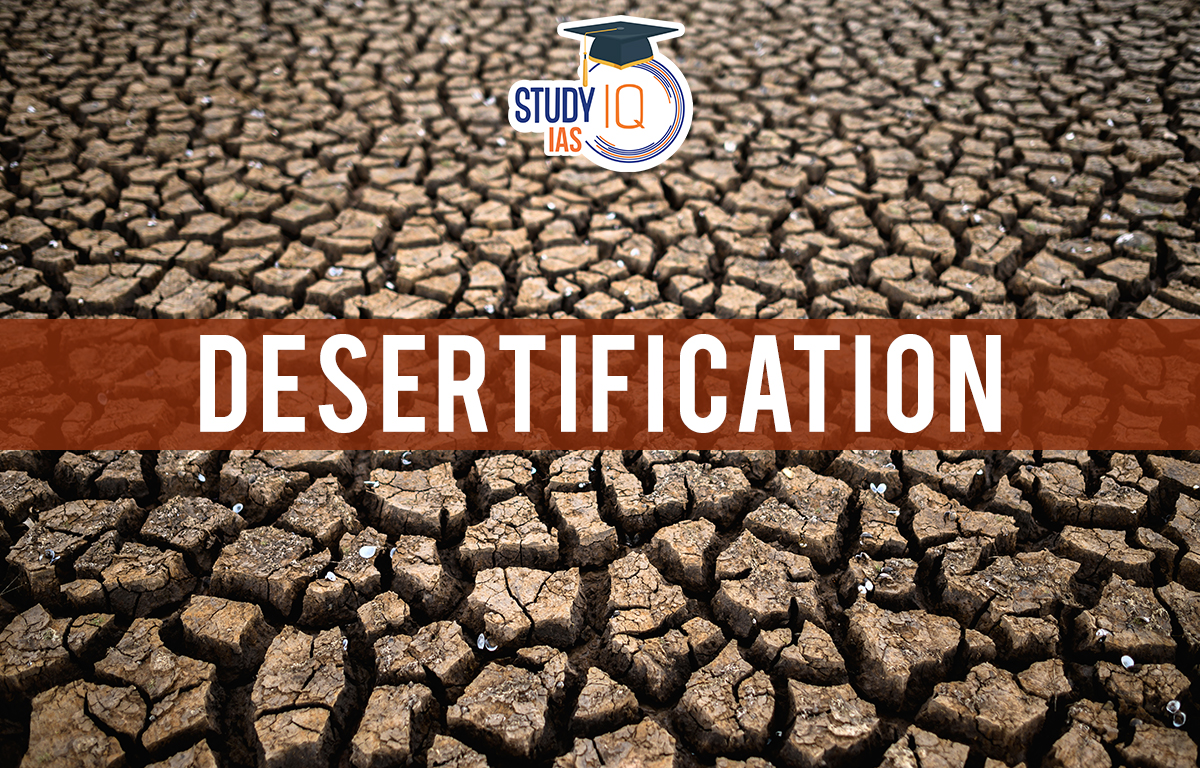Table of Contents
Desertification
Desertification is when drylands (arid and semi-arid areas) lose their ability to support life due to natural or human causes. It does not mean deserts are getting bigger. Desertification happens in dry areas because of human activities and climate changes. It does not mean existing deserts are expanding.
Almost 29% of land in India, which is about 96 million hectares, is getting worse. According to government information shared with the UN, India lost 31% of its grasslands, or 5.65 million hectares, in just ten years. In total, over 105 million hectares of land in India is degraded, making up about 32% of the country’s area. Between 2003-05 and 2011-13, desert land increased in 26 out of 29 states. More than 80% of the degraded land is found in just nine states.
This article will explain to you about Desertification which will be helpful in preparing the Environment Subject of UPSC syllabus for the UPSC Civil service exam. The UPSC Mock Test can help candidates prepare for the exam with more precision.
Desertification Meaning
Desertification happens when rich land loses its natural resources like plants and animals due to deforestation, drought, climate change, human activities, or poor farming practices. In simple terms, desertification means the soil can no longer support crops, livestock, or wildlife
Also Read: Land Degradation
Desertification Causes
Man-Made Causes:
- Overgrazing: Reduces land’s usefulness and biodiversity. India lost 31% of grasslands between 2005 and 2015.
- Deforestation: Releases carbon dioxide, contributing to the greenhouse effect.
- Farming Practices: Slash and burn, heavy tilling, and overirrigation harm soil.
- Urbanization: Increases resource demand, leading to desertification.
- Climate Change: Alters temperature, rainfall, and winds, worsening desertification.
- Overexploitation of Resources: Overpopulation increases land resource demand, making land vulnerable.
Natural Causes:
- Natural Disasters: Floods, droughts, and landslides cause water erosion and soil displacement.
- Water Erosion: Leads to badland topography, an early stage of desertification.
- Wind Erosion: Sand carried by wind reduces soil fertility, leading to desertification.
Desertification Effects
Land degradation and desertification have severe environmental, economic, social, and political impacts. Environmentally, they lead to the destruction of vegetation, soil infertility, increased soil erosion, greater vulnerability to natural disasters, water pollution, and loss of biodiversity, including species extinction. Economically, they increase the frequency of natural hazards like floods, landslides, and droughts, threaten agricultural productivity, and exacerbate poverty, reducing the overall productivity of the economy. Socially, these issues cause famine, poverty, and social conflicts, forcing mass migrations and creating food security problems. Politically, the repercussions can lead to instability and unrest.
- Desertification and land degradation threaten global agriculture, clean water, and air.
- Soil degradation and expanding deserts reduce food production and dry up water supplies.
- Declining agricultural productivity affects many people’s livelihoods.
- Growing global population increases environmental pressure and food shortages.
- Degraded land ca not absorb carbon dioxide (CO2), worsening global warming.
- Surface and groundwater resources are decreasing in quantity and quality.
- Desertification endangers local plants and animals.
Desertification’s Impact on Human Health
Malnutrition happens when there is not enough food and water. Infections spread through dirty water and food due to poor hygiene and lack of clean water. Air pollution and dust from wind erosion cause breathing problems. When people move, they can spread contagious diseases.
Desertification Prevention
- At some soil depths, vacant layers of sand and gravel form salt traps. These traps reduce water loss by preventing salts from reaching the soil’s surface. Improving irrigation can stop salt buildup and reduce water loss by modifying irrigation designs to prevent water from collecting or evaporating quickly.
- Cover crops stop wind and water-borne soil erosion. They also lessen drought effects locally. On a larger scale, vegetation helps maintain regular rainfall patterns. Perennials or fast-growing annuals can be used as cover crops. Crop rotation, alternating different crops on the same land in different seasons, helps maintain soil productivity by replenishing vital nutrients lost during harvest.
- Rotational grazing reduces cattle grazing pressure in an area. Livestock is regularly moved to different grazing sites before they permanently damage the vegetation and soil. Terracing creates layers of flat land like long stairs on hillsides, slowing runoff, reducing soil erosion, and delaying water loss.
- In contour farming and contour bunding, lines of stones are laid out according to the terrain’s natural rises. These methods help capture and retain precipitation before it becomes runoff. They also prevent wind erosion by keeping the soil moist and heavy. Windbreaks are rows of fast-growing trees planted perpendicular to the main surface winds to slow down wind-driven soil erosion and prevent dunes from encroaching.
- Protecting the plant population along the edges of dunes helps stabilize them. The root systems hold the soil together, while the upper parts of the plants shield the soil from surface breezes.
Desertification UPSC
If allowed unchecked, desertification and the decline of dry land ecosystem services could jeopardize future advances in human well-being and potentially undo some of them. The best chance the world has to lessen the effects of climate change, protect species, and protect human well-being is to stop desertification. People and governments everywhere around the globe have a shared responsibility to protect the planet’s forests. Students can read all the details related to UPSC by visiting the official website of StudyIQ UPSC Online Coaching.


 Purchasing Power Parity Index, How to Ca...
Purchasing Power Parity Index, How to Ca...
 Unemployment Rate in India, Current Rate...
Unemployment Rate in India, Current Rate...
 RBI Monetary Policy Committee: Repo Rate...
RBI Monetary Policy Committee: Repo Rate...

























